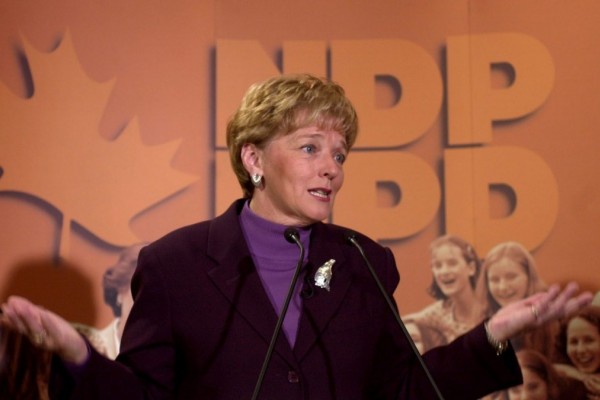The Violence that Indigenous Women Face (Anna Hunter)
March/April 2005 Issue
The city of Port Coquitlam is currently primed for the much-anticipated B.C. Supreme Court case concerning the serial murders of 15 women (from a list of 61) reported as missing from Vancouver’s Downtown Eastside since 1983. In northern British Columbia there are increasing demands for official answers about the “Highway of Tears,” a section of Highway 16 between Prince George and Prince Rupert along which predominantly Aboriginal women have gone missing, and are presumed dead. Last year in Prince Albert, Saskatchewan, a young native woman was dragged to her death by a pickup truck after a racialized alteration outside a city bar.
These are just a few of the stories behind the troubling statistics of violence that face Indigenous women in Canada. According to records held by the Native Women’s Association of Canada, there are currently at least 500 Indigenous women that have been murdered or missing, and are presumed dead, across the country. These numbers do not address the multitude of unreported and under-investigated cases of extreme violence routinely perpetuated against Indigenous women. The root cause of this murderous violence and mainstream society’s seemingly casual indifference is structural and systemic. It lies in the interconnections between one’s race, culture, class and gender, which have routinely marginalized so many Indigenous women beyond any reasonable expectation of security of life and person.
In October, 2002, Amnesty International released a report, Stolen Sisters, an investigation by Mohawk lawyer and activist Bev Jacobs into the issue of violence against Indigenous women in Canada. The report makes a compelling argument that violence against women, and certainly violence against Indigenous women, is more than a criminal concern or social issue; it is a human-rights issue. All women have the fundamental right to be safe and secure from violence. Why, then, does this heightened state of violence against Aboriginal women continue to cross inter-generational and geographic boundaries in such a pervasive manner?
The Colonial Underpinnings
To understand violence against Aboriginal women, the situation must be situated within the surrounding legacy of the colonization of Aboriginal women. Aboriginal women have endured countless legislative intrusions directed at assimilating and controlling the four spheres of everyday tribal life: political, social/kinship, spiritual and the land. Most Canadians have come to realize that the federal government has promoted an agenda of assimilation and control of Indians though policies such as the Indian Act and residential-schools policy. This increasing awareness must be matched by an understanding that colonial practices take many forms and varieties that stretch beyond government actors to include those with institutional capacity to legitimize the colonial order, including educators, media personnel, lawyers, judges, police officers, literary authors and publishers, historians and scientists. The cumulative result of the insidious phenomenon of colonization is the extreme marginalization of Indigenous women from the social safety nets of society. Not only do Indigenous women face the routine dispossession of their inherited rights, lands, identities and families, they also face disenfranchisement from institutional and societal protections designed to protect them from violent predators.
Indigenous women live with the knowledge that legislated and institutional responses are typically creations of the colonizer state with its patriarchal underpinnings, which leaves them fundamentally inadequate in terms of addressing the violence specific to Indigenous women. Indigenous women remain fully aware of the inherent limitations of turning to a justice system that has enabled a series of competing inequalities based upon one’s gender, race, culture and economic standing. Think about it. How likely is an Aboriginal woman to turn to the same system that has manifested its judicial powers against Indigenous people to such a degree? Is there really an expectation that she may turn for assistance to the same systems that may have incarcerated her family members or removed her children from her care? The state has been used for generations to undermine family and community life for Indigenous people, which has in turn led to a fundamental lack of trust in the system that must be acknowledged.
Even when this barrier of trust is removed and crimes against Indigenous women are reported, there are further competing issues within the institutions of public redress. Anyone who enters the systems must be ready to deal with prejudicial determinations about occupational and lifestyle choices. Police routinely dismiss reports of missing women on the basis of lifestyle issues, like prostitution, drug use and addiction. In Vancouver, the police dismissed reports of women missing from the Downtown Eastside for over a decade, citing the transient nature of the women’s lives. Family members of the missing women knew that these women had broken from the patterns of their lives in fundamental ways, including failure to collect prescriptions and to cash government benefit cheques, but officials refused to duly investigate.
And, then, once investigations begin, Indigenous women find themselves under the judgmental gaze of the media. Society is fed sensational media reports that focus upon the character of the victim, and even the character of the victimizer. These mainstream media reports do not make the underlying connection to the series of colonial and patriarchal government policies that have wreaked havoc in Aboriginal communities, and that have left many Indigenous people trapped in a downward spiral of a combination of poverty, homelessness, prostitution and addiction.
The most dangerous aspect of this situation is that there is an increasing awareness that serial killers and violent offenders are also aware of the built-in limitations of the institutionalized justice systems. In a special investigation on how American police fumble missing-persons reports, Mike Barber of the Seattle Post-Intelligencer writes that experts know that serial killers, the sexual psychopaths and sociopaths whose crimes generally appear random and motiveless, are adept at using the system against itself. According to Barber, predators target vulnerable people, usually those that have been marginalized – prostitutes, drug users, homosexuals, farm workers, hospital patients and the elderly. Because Indigenous women also find themselves within these vulnerable fringes of society, they find themselves in the role of prey.
Envisioning and Enacting the Changes We Want to See
Similar to most social-justice advocates, activists working to end violence against Indigenous women know that when change is necessary there is a need to envision the necessary changes and then work vigorously to enact them. As a result of these efforts, we have safe houses in Aboriginal communities across the country that provide shelter and care to Indigenous women in crisis. We also have documentary filmmakers like Audrey Huntley and Christine Welsh, who chronicle the many stories of the missing and presumed-dead Indigenous women. And the MissingWomen.net website continues to compile and document the stories of the missing women for the World Wide Web to see.
These actions are joined by the Native Women’s Association of Canada, which is wrapping up its year-long “Sisters in Spirit” Campaign in March, 2005. NWAC has been gathering the names and stories of Aboriginal women who have disappeared in large and small communities across the country, in order to honour these Indigenous women who have gone missing and been brutally murdered. This national campaign has been joined by an international human-rights campaign through Amnesty International. With the release of the 2004 Stolen Sisters report and an international action appeal, Amnesty International is also actively involved in the campaign to urge immediate government action to ensure the safety of Indigenous women in Canadian cities.
Each of these examples affirms the individual and collective responsibility that we each share to ensure that this untenable situation of violence against Indigenous women will not be tolerated any longer. We need to consider these individual stories of pain and hardship within a deeper understanding of the societal impacts and colonial underpinnings of the particular situation. As the “Sisters in Spirit” campaign website states, “Now is the time to take concrete steps to ensure that the lives of Aboriginal women in Canada are no longer treated as disposable.”Anna Hunter is a member of the Ktunaxa Nation, located in southeastern British Columbia, and is the mother of a beautiful young daughter, Alexandra. She joined the faculty of the Department of Political Studies at the University of Saskatchewan in July, 2002. Her area of academic specialization is public administration and Aboriginal governance and politics. Her latest research is focused upon the participation of Aboriginal peoples in federal elections.









